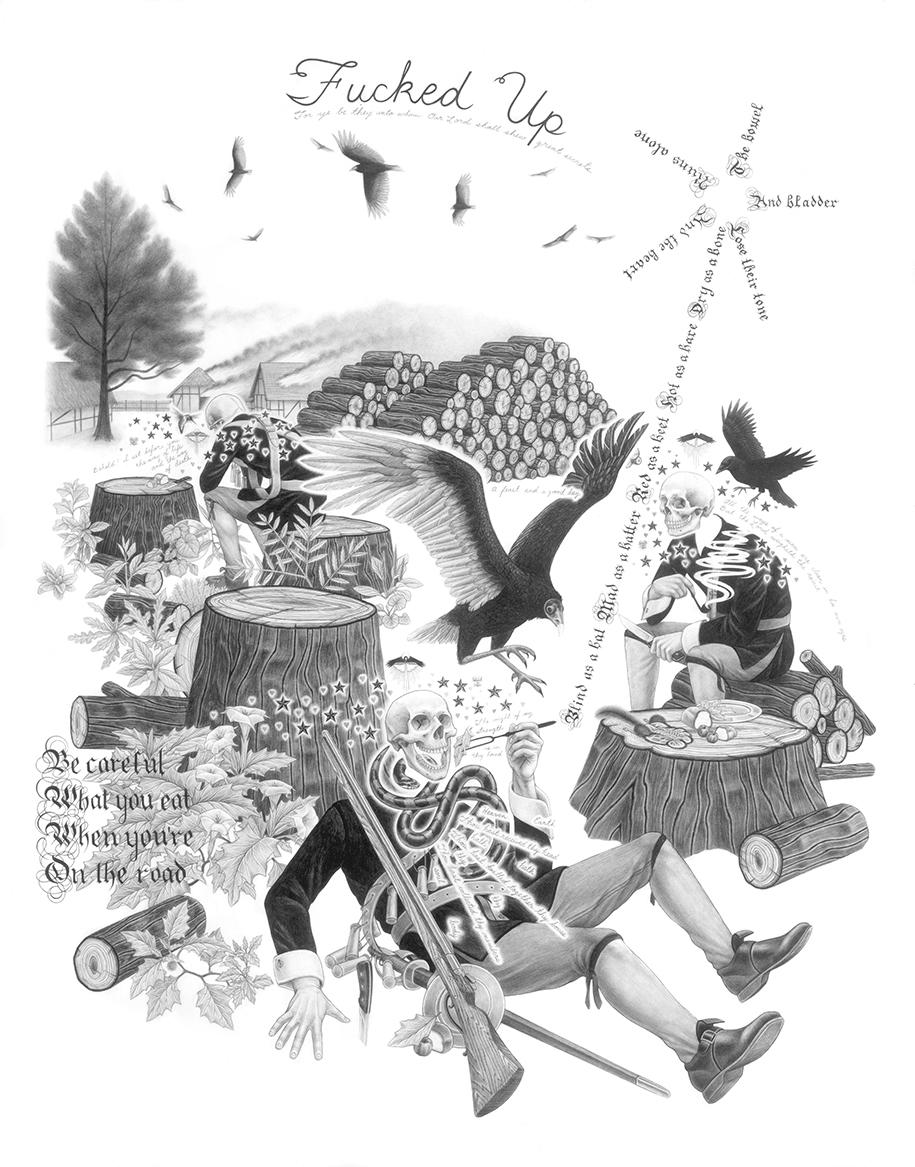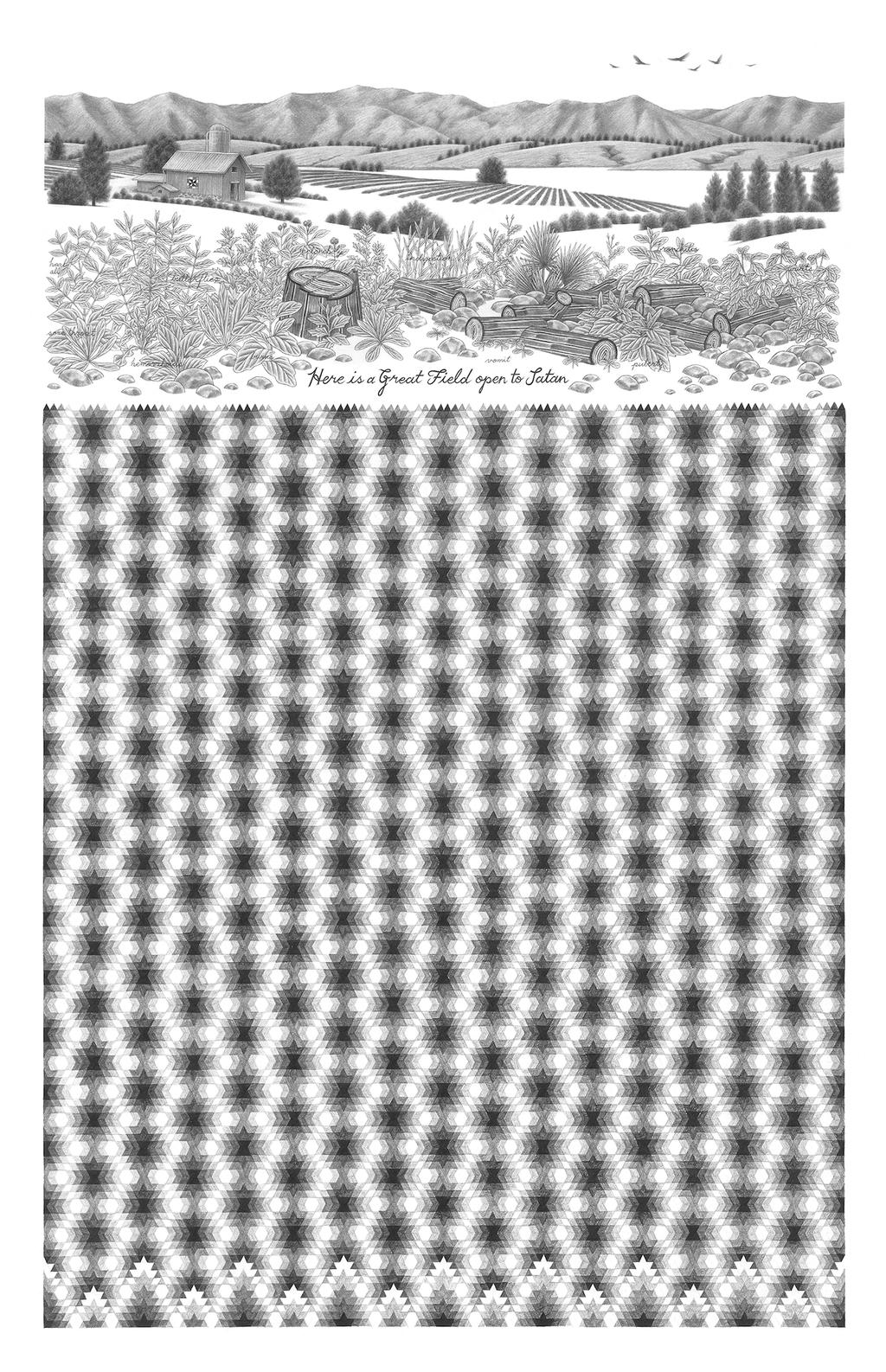
ERIC BELTZ
history is referential

“I used to stay at this hotel in Hollywood, and my room had just about everything I needed: a bed, a dresser, a writing desk, a bathroom, and a window out onto Sunset Blvd. I thought that this was a great way to live... you know, with very little. So when I found graphite and Bristol, they felt right. They offered a narrow road filled with what still feels like unlimited possibilities.“

Even though it is obviously pretty easy these days to discover new artists by the minute, it happens just once in a blue moon that you trip over somebody’s work that isn’t only outstanding in its actual execution but brings something new and entirely incomparable into your world. And Santa Barbara-based Eric Beltz is a prime example of being exactly such an artist. His work basically is an ordeal for anyone with a short attention span, as it clearly demands a lot of time to decode his drawings - incredibly detailed studies in graphite that depict a completely new kind of Americana. Beltz tends to work in series, in which he reinvents American foundational narratives with rich historical detail, up to the point where the finished drawing - manufactured in a painfully time-consuming process that can take many months - lives in a world apart from the pure forms of the genres upon which it may draw. In this case: Founding Fathers, botany, religious hysteria, psychedelia, shamanism, puritanism, nature, spirituality and profanity are opposed to cryptic texts that even expand the cultural crossover. And then there’s Poison Oak Man. Lodown had a chat with the outstanding artist - who not too surprisingly is also teaching drawing at University of California in Santa Barbara - in late October '15.

Eric, your work is highly elaborate on many different levels, so I guess it was quite clear early on that you’d choose a career as an artist over any other option that might unfold, right?
The elaborate, multi-layered, and highly-detailed aspect of my work comes from a desire to try and push graphite as far as I can. On the other hand, I like things to be simple. I used to stay at this hotel in Hollywood, and my room had just about everything I needed: a bed, a dresser, a writing desk, a bathroom, and a window out onto Sunset Blvd. I thought that this was a great way to live... you know, with very little. So when I found graphite and Bristol, they felt right. They offered a narrow road filled with what feels like still, unlimited possibilities. At least that is the challenge, to have this limited media and color range but still feel like they represent expansiveness. I also love to write so it feels natural to draw. And I like the idea that if I were to lose everything, I could rebuild my studio with two things: pencil and paper.
You integrate a lot of diverse influences into your work: religion, psychedelia, myths and then some. Since you tend to work in series, would you say that there’s a kind of coherent narrative to it as well?
There is no coherent narrative between drawings or even within series. The way I bracket groupings is by the impulse that generated them. And that is hard to define but when I feel that impulse shifting I create a new series to move the new work into. My work is getting more rich in detail and consequently each drawing is taking longer to do. This also causes me to rethink the ideas of series – that maybe this doesn’t serve me anymore. If I make one drawing that takes me eight months, does it really have anything to do with the next one that might take three or four months? Over that long of a time, I become absorbed in that one drawing, trying to find everything it needs. I don’t work on more than one drawing at a time. It is an exhausting process and once I am done I wonder what can that one drawing have in common with whatever comes next? I am thinking now of my drawings as each being a more or less unique essay. I am making all of them so there are common threads but each drawing goes its own way.
Since you also integrate a lot of text fragments into your work, I was wondering a) where these texts root from and b) about the actual intention behind creating this kind of new Americana?
I have borrowed a lot of text from a variety of sources. When I read I write down phrases that I think are interesting, have a certain music to them, or have something beautiful about them. I try to pull quotes from sources that were written to not have beautiful language so that I feel like I am finding the beauty myself. I used to then kinda jam all this stuff together without really worrying about how rational or coherent the entire text was... but now I am starting to smooth out the connections between unrelated fragments but also write my own – which is a little scary because it makes me more vulnerable. After ten years of quotations I need to start writing my own words.
Obviously, it’s easy to lose yourself in your drawings for purely aesthetic reasons... would you say that having knowledge about history will double the fun, so to speak?
Yes, indeed. That is why I try to write fairly detailed descriptions of each drawing. So that if someone is interested in one of my drawings, they can actually learn more, get my take on it, and check their own guesses against my thoughts. I think that creating curiosity in someone to the point that they act on it, is a great function of art. It isn’t just showing someone something new, it is inspiring them to act on their own... which can lead to them doing something on their own. Curiosity and action are gifts.
You love to work with graphite... would you say that this technique is close to being an endangered species in our day and age?
Drawing is one of the most accessible ways to participate in art, visual communication, and perception. It will never go away. Everyone starts with drawing. I think the common use of digital animation in movies is making drawing a vital component to training young artists. It’s how they learn and practice the techniques they’ll eventually apply with digital drawing tools. So if anything, drawing is finding a deep place in the culture.
By looking at a whole series of your work, there’s this subtle sense of unease and doom taking over... how come your vision is a rather bleak one?
There is dread and doom in my work. There is darkness, too. I often use tree stumps to signify the destruction of nature. But I have a line I have used in a few drawings: when a tree falls there is a new forest. So I look at death as part of a process, it is an opportunity for something else to grow. Of course to the dead there is loss but to the next generation there is potential.
I am working on two drawings right now. “The Body Of Adam“ is continuing my interest in early Christian Apocryphal Gospels. I am also trying to develop a character I created a few years ago: Poison Oak Man. He is a skinless creature who wanders around cutting down poison oak and creates a skin for himself out of the leaves. Poison Oak Man also has some poetic impulses in a vein related to the visionary poetry of William Blake. He is a messy character but I am really looking forward to working on him in the future. And he is the character that I am using to help me write my own text for my newer drawings.








